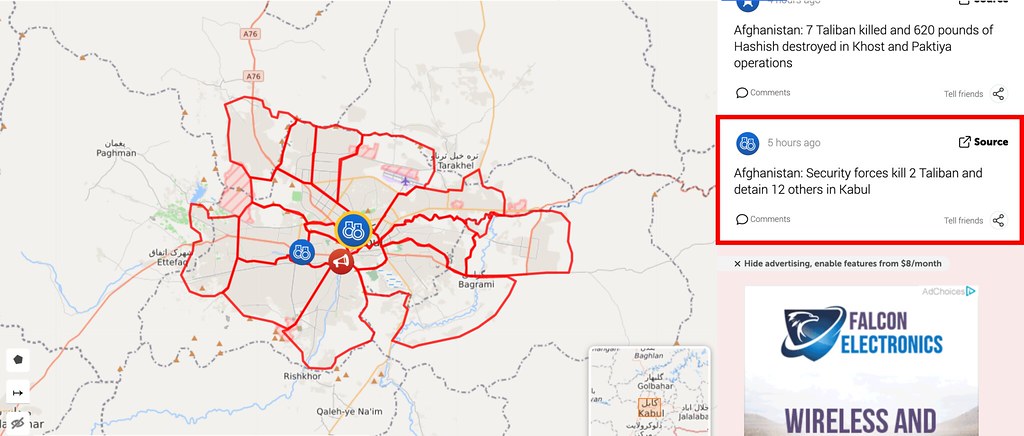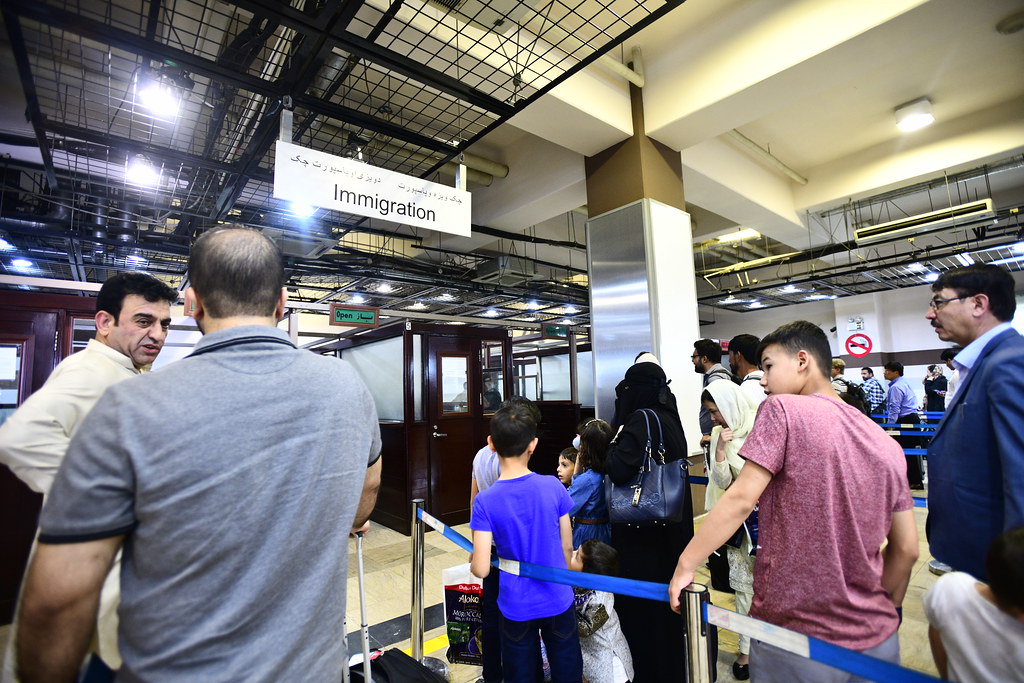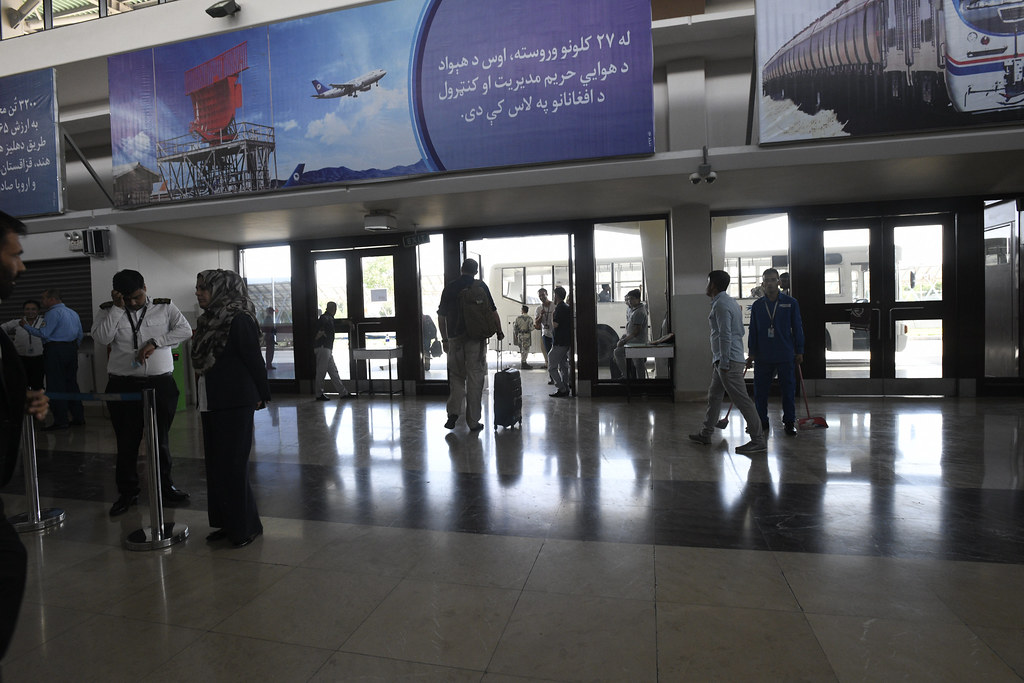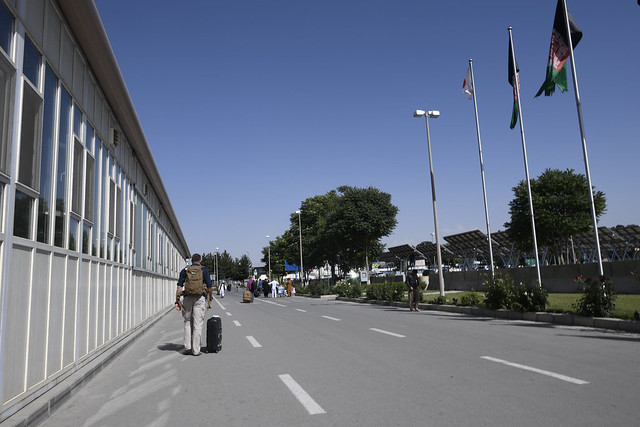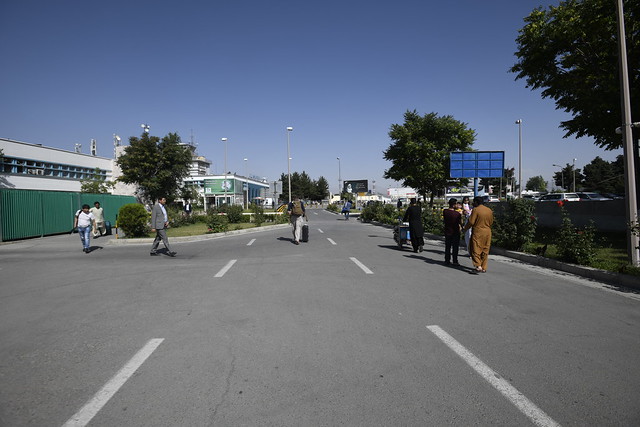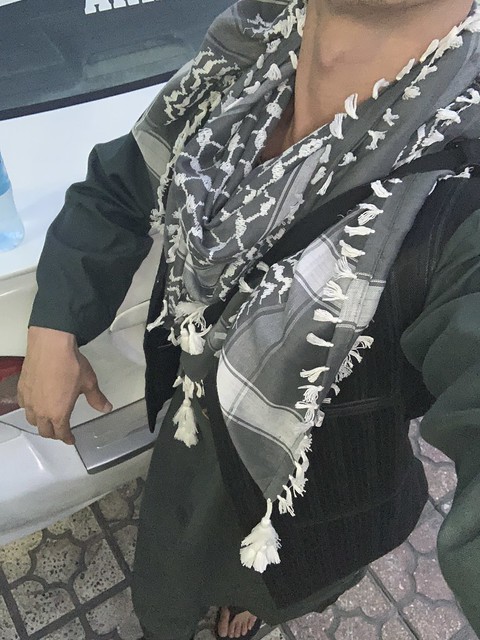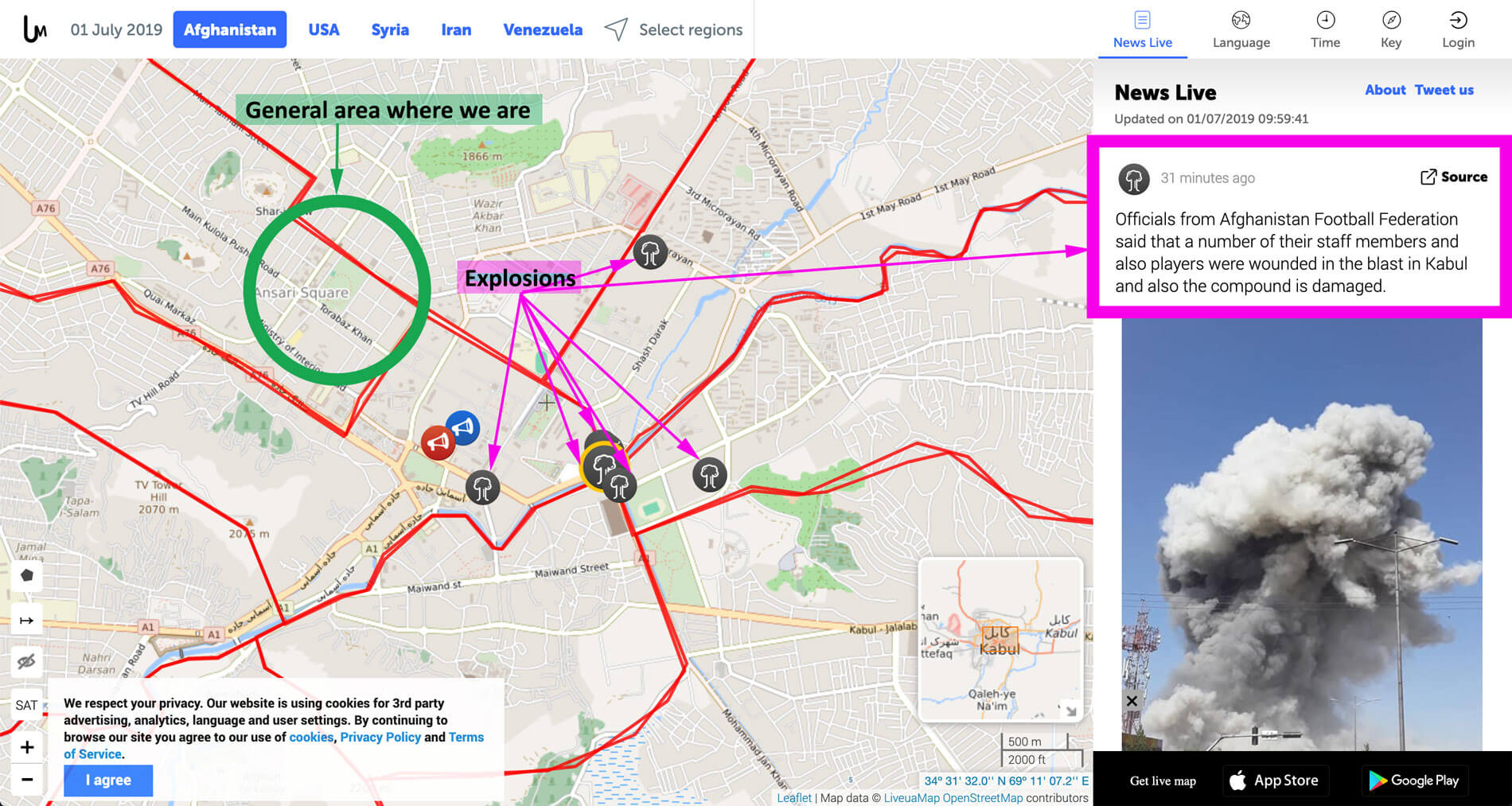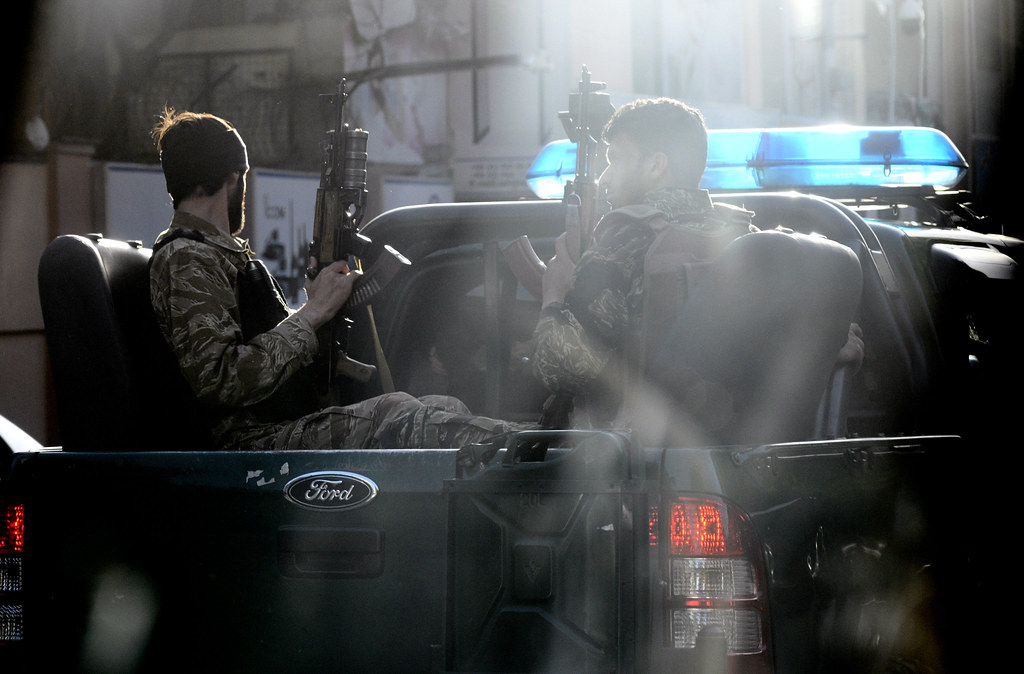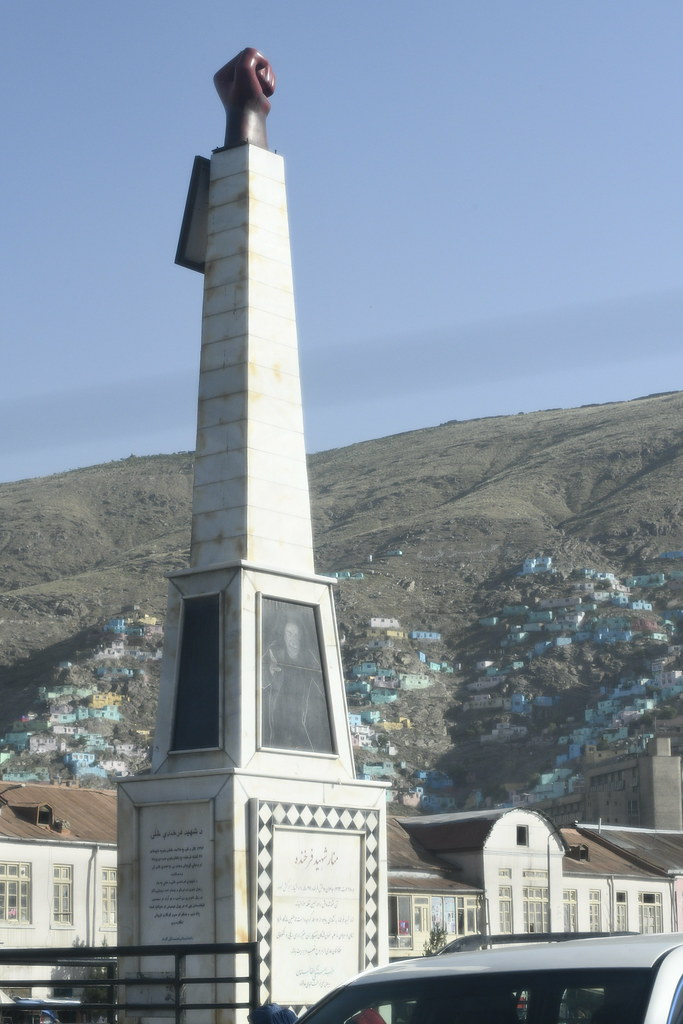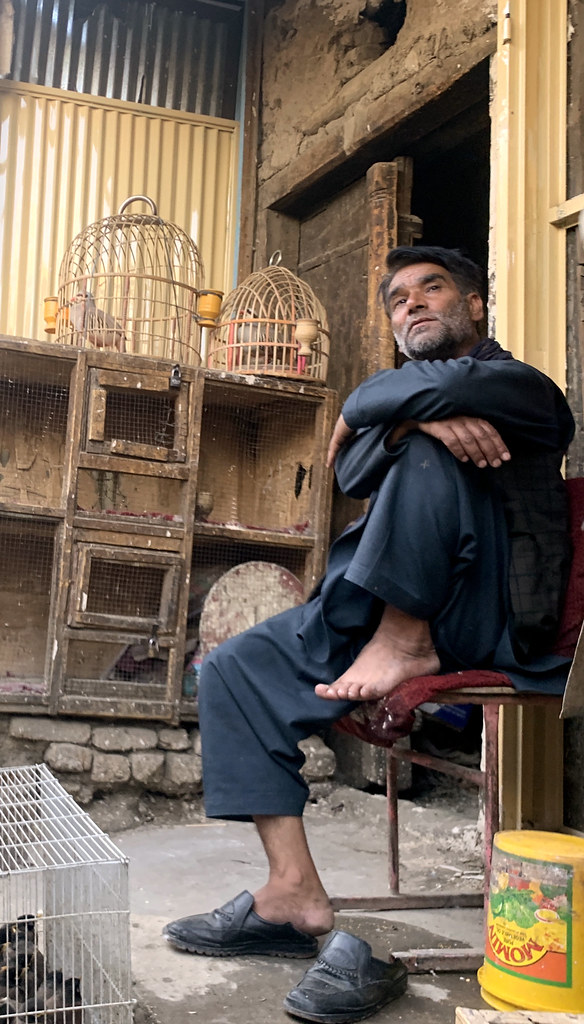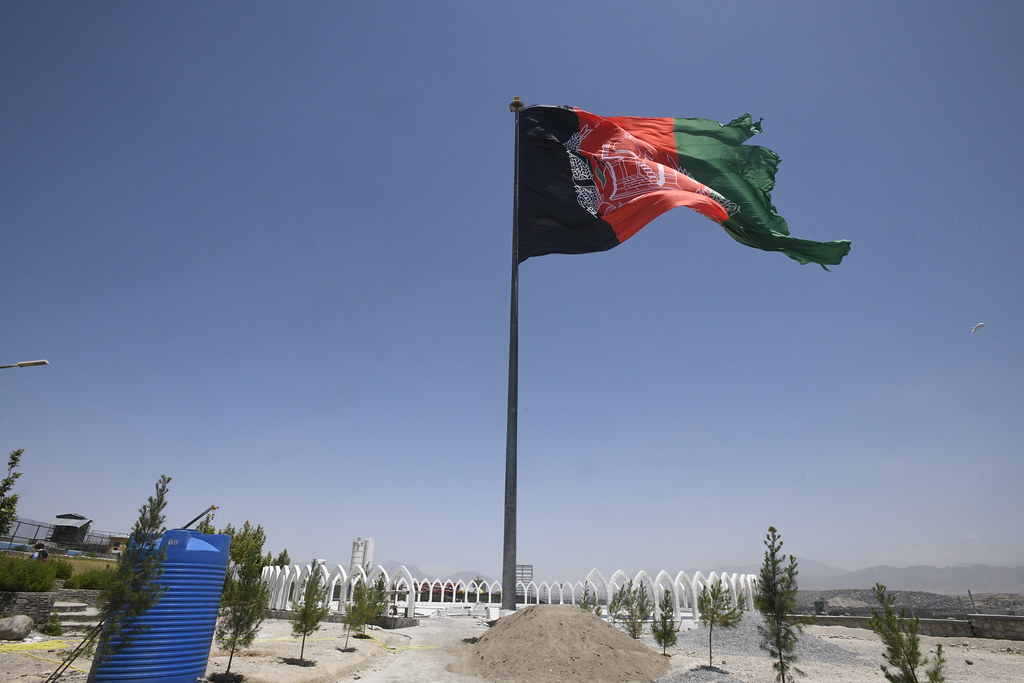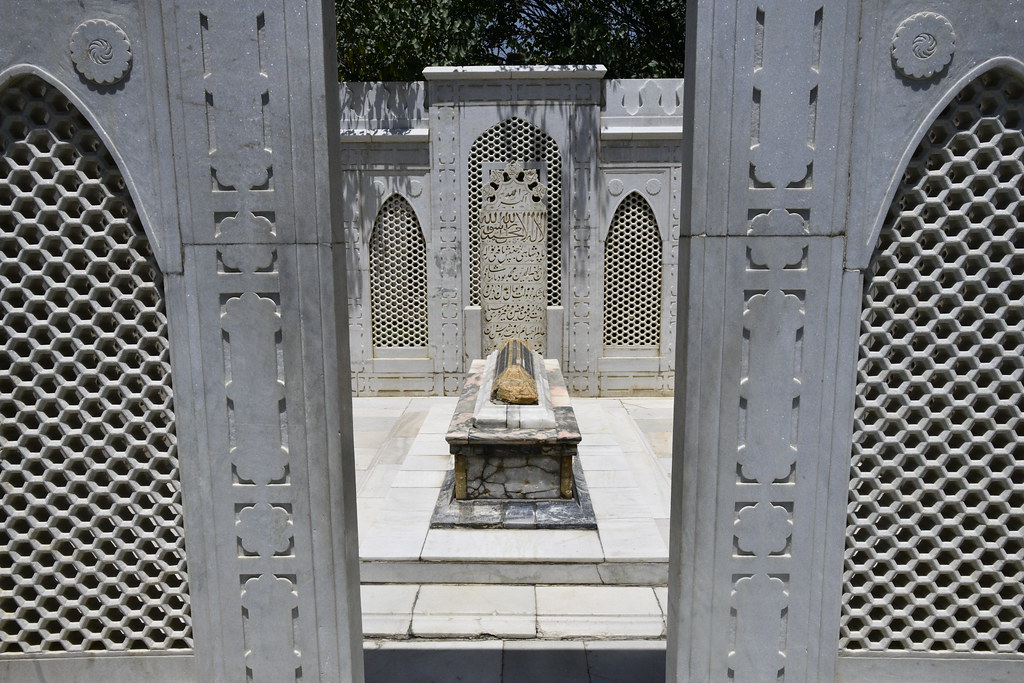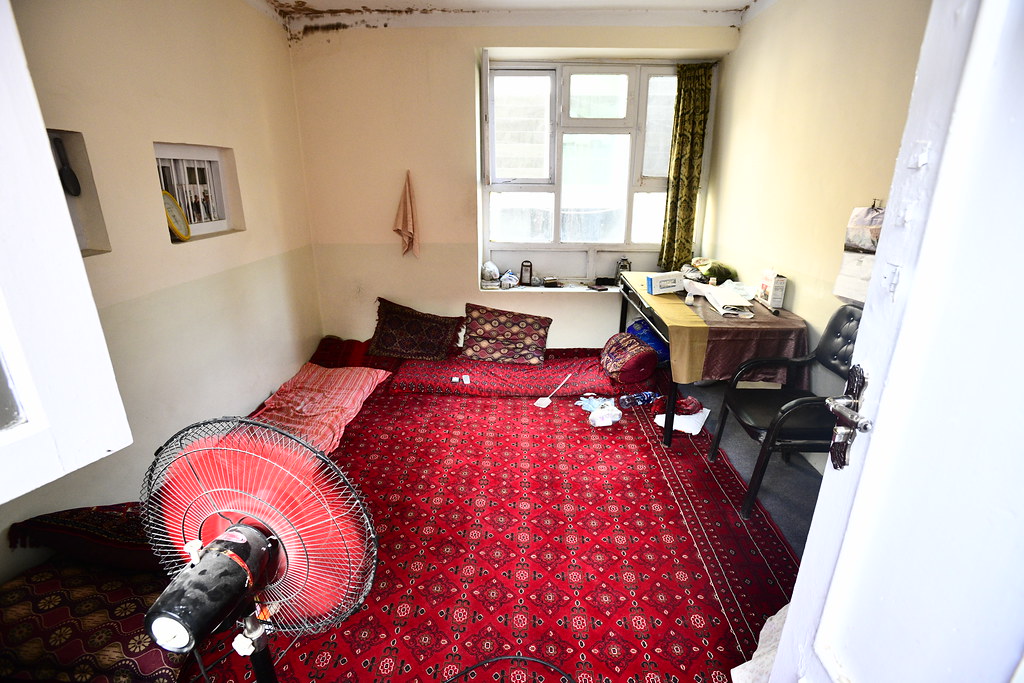(Given the ever-changing security situation here, this post will be updated as circumstances develop so check back often)
Travel Warnings
A helpful warning as I set off for Kabul today:
Do not travel to Afghanistan due to crime, terrorism, civil unrest, kidnapping, and armed conflict.
Travel to all areas of Afghanistan is unsafe because of critical levels of kidnappings, hostage taking, suicide bombings, widespread military combat operations, landmines, and terrorist and insurgent attacks, including attacks using vehicle-borne, magnetic, or other improvised explosive devices (IEDs), suicide vests, and grenades.
Terrorist and insurgent groups continue planning and executing attacks in Afghanistan. These attacks occur with little or no warning, and have targeted official Afghan and U.S. government convoys and facilities, local government buildings, foreign embassies, military installations, commercial entities, non-governmental organization (NGO) offices, hospitals, residential compounds, tourist locations, transportation hubs, public gatherings, markets and shopping areas, places of worship, restaurants, hotels, universities, airports, schools, gymnasiums, and other locations frequented by U.S. citizens and other foreign nationals.
The U.S. Embassy’s ability to provide routine and emergency services to U.S. citizens in Afghanistan is severely limited, particularly outside of Kabul. Evacuation options from Afghanistan are extremely limited due to the lack of infrastructure, geographic constraints, and the volatile security situation.
Family members cannot accompany U.S. government employees who work in Afghanistan. Unofficial travel to Afghanistan by U.S. government employees and their family members is restricted and requires prior approval from the Department of State. U.S. Embassy personnel are restricted from traveling to all locations in Kabul except the U.S. Embassy and other U.S. government facilities unless there is a compelling U.S. government interest in permitting such travel that outweighs the risk. Additional security measures are needed for any U.S. government employee travel and movement through Afghanistan.
Due to risks to civil aviation operating within or in the vicinity of Afghanistan, the Federal Aviation Administration (FAA) has issued a Notice to Airmen (NOTAM) and/or a Special Federal Aviation Regulation (SFAR). For more information, U.S. citizens should consult the Federal Aviation Administration’s Prohibitions, Restrictions and Notices.
Yep, even 5 hours ago after arriving and driving around something just happened here:
But to be perfectly honest, we drove right by this police convoy that was apprehending the Taliban and we heard no commotion whatsoever. Just a lot of cars honking in a typical traffic jam.
In fact, other than the usual security precautions of not posting until after we left the place — and an attack a few minutes ago on our very last day here (more on that later) — my entire week at Afghanistan personally felt completely safe and remarkably uneventful. Tourists are never a target. The locals have been friendly, the sights have been beautiful, and all in all, not once did I ever feel the least bit of worried for my well-being during my time here.
Except for a handful of minutes on my last day in the country, the most surprising thing about Afghanistan was how normal it felt to be here.
Arriving (The Airport)
On Monday I took the 2.5 hour Emirates EK640 flight from Dubai to Kabul departing at 11:10am:
As we approached our landing:
We disembarked at 2:30pm.
Unlike obtaining my visa for Afghanistan, getting through immigrations took less than 5 minutes. They simply take a photo of you and your fingerprints.
Given the understandable security situation in this part of the world, I was instructed to obtain a temporary ID card from the small blue booth facing baggage claims. I had prepared two 2×2 passport photos ahead of time so I could expedite everything.
However, it occurred to me I would be the only one in the group to have this ID card as everyone else reported that the booth was closed when they arrived.
Once I had my temporary ID card (which took 3 minutes for them to make), I left the terminal, turned left and followed the rest of my fellow passengers.
Non-flyers are not allowed into the terminal building so I had to leave the airport entirely to reach my greeters and guides who had a sign with my name and his own special ID card with clearance to be there.
I had mistakenly wandered into the diplomatic area first, but it seemed nobody cared about my presence before I re-entered the airport and exited the normal way.
And with that I was on my way!
Money
Regarding money, there are a number of moneychangers within two minutes walk of our guesthouse that changed USD to local Afghanis at a good rate at 80 to 1.
It is recommended that you bring all the cash you need for a time exchange; ATMs are understandably scarce and the existing ATMs usually never work…except for a few that I found in hidden grocery stores!
Food & Drink
We chose lunch and dinner at various heavily guarded restaurants during the day as our guide arranged everything ahead of time. Afghan cuisine has been a clear intersection of recognizable Persian/Iranian and Pakistani staples.
Alcohol is obviously banned and is difficult and expensive to find.
My favorite place was a café called Tea Time that served great shisha, fantastic food, and even better tea and fresh mango juice:
Much to my surprise, the entire group generally has been feeling fine the entire week with Afghan cuisine. There has been one exception of someone who vomited once on day one and felt fine since, and another whose diet simply couldn’t get used to the change in Mazar-e Sharif. I’ve been totally fine despite me eating everything in sight; TMI, but so far not a single episode of diarrhea!
Lodging/Power
I recommend choosing a hotel/accommodations that’s NOT The Inter-continental, The Serena, or any of the world-class hotels that are frequently targeted by terrorist groups. We’re staying at a secure hotel complex and conference center inside the Kabul city center but it’s completely hidden away by tall walls and unmarked doors.
I can’t tell you where we are exactly to preserve the safety of future travelers (it doesn’t even have an official name or show up on Google Maps!), but you can privately message me if interested.
In fact our hotel is so secure that a TV crew came by after our breakfast to set up a shoot here for a broadcast on government-sponsored female contraceptives!
Power was also pretty reliable in Afghanistan. Other than a rolling blackout that happened once or twice (and was barely noticeable), everything was chargeable. I barely used my portable charger at all this past week.
At least most hotels have great WiFi if anyone wants to stay connected; in our rooms I was able to upload photos at 4G/LTE speeds!
Cultural Faux Pax
As we arrived, we were given our choice of clothing. As Afghanistan remains a conservative Islamic country, women are required to wear a headscarf and long sleeved clothing that obfuscate the shape of their bodies. Men wear long trousers. Luckily given the weather, Afghan clothes are light and breathe very well.
When I got my clothes, they felt so light and freeing I wore the same outfit everyday for a week.
Despite hearing of the infamous conservatism, we found Afghans to be extremely forgiving for any cultural faux pas. There are a few following things we made sure to do, however:
- Always ask before taking photos, especially regarding to women and people praying
- Asian households! Take off you shoes if entering a mosque or someone’s house. Hold soles together.
- Never walk in front of someone if they are praying.
- Never directly expose the bottom of your feet to anyone
- Don’t talk too loudly
- If you are of the male persuasion then do not start talking to/interacting with local women unless they approach you first.
Security and Safety
Yes, to get this out of the way: As I’m writing this a few explosions just occurred within our vicinity a few km away (it’s already on the news). Still hearing some gunfire in the distance where the plumes of smoke are.
We just went up to the rooftop to take a look:
What is remarkable is how the hotel staff and even some of the people in our group remain so blasé right now as if we had heard a car accident just happened a few blocks away. We’ve been here a little over a week and the desensitization is very real, even though nothing close to this has happened during our 7-8 days here. We even went out for lunch outside an hour later. As our guide informed us, most of the attacks occur between 7am-10am at the same places to target the morning commutes of VIPs and foreign workers. Tourists are never a target.
And regarding overall security and safety, the areas we otherwise have been visiting in Afghanistan are where our guides feel comfortable that they can take us without any unforeseen or undue risk. There really have been no other incidents.
On another note, narcotic drug use is unfortunately publicly rampant on the streets of Kabul. The users tend to keep to themselves, so they won’t bother you if you don’t bother them.
FYI, speaking of security you will always notice the 24/7 all-seeing surveillance blimp (aka the “dirigible“) the USA has set up over Kabul:
The following things are important should you find yourself visiting Kabul at this time:
- Never discuss your itinerary or name of hotel with anyone you meet. While the question may arise in curiosity, please keep the schedule to as few people as possible as a precaution
- Never take photos of any military personal, vehicles or installations.
- Take early starts on the days if you plan to travel long distances. In the case of a breakdown, you do not want to be stuck on the road after dark.
- Register with your foreign office. If you go to your countries foreign office website there is usually a form you can complete to let them know where you are. This is so if there are any problems and you need their help, your embassy will be much more helpful if you have registered with them
- If you get invites for tea or for dinner from people, which is one of the great things about visiting Afghanistan, stay cautious. Follow your guide’s lead if he feels taking up such an invite may be inappropriate
- Watch and listen to your guide. He has a lot of experience in Afghanistan and may see signs that things are not as they should be before you do.
- If you disagree with your guide, the time to argue and discuss what to do is later in the hotel. So if your guide asks you to do something, do it and then argue about it later.
Military Presence
They may be everywhere, but they’re not menacing. Most are local Afghani troops and police forces. I only noticed coalition/Western forces stationed at the airports and inside bases.
Nevertheless, get used to the sound of Osprey/Chinook helicopters every 5 minutes and the constant traffic jams due to military and police checkpoints at the roundabouts.
Packing
This was my packing list (and this is overdoing it):
- Comfortable clothes for wearing around the hotels
- Conservative, loose fitting clothes for when you first arrive (or buy them on day one)
- Headscarves for women
- Plastic carrier bags. Very useful for dirty washing, dirty shoes, rubbish and keeping stuff dry.
- Spare passport photos for use at the borders
- Flashlight
- Flip flops/thongs for bathrooms
- Small packs of tissues and wet wipes
- Money belt or secure pouch
- Sunscreen
- Sewing kit
- Sunglasses
- Writing materials
- Plenty of spare film or memory space
- Some small gifts can be nice as presents
- Umbrella or Keffiyeh for small bouts of rain
- Towel
What To Visit
That said, what did we see in Kabul? There’s so much! On my first day arriving when I bought some local clothes to blend in, I found myself at a street shop outside the largest mosque in Kabul, built 6 years ago.
We then strolled down Chicken Street, formerly the most hip place in town and more notoriously the site of the recent Taliban ambulance bombing on January 27, 2018 that killed 103 people and wounded 235 others.
Now you can’t tell if anything ever had happened here:
There are street shops here selling everything a tourist would want in souvenirs including this gem:
In fact we walked up and down this street more than one occasion each for an hour doing some shopping. Locals greeted us without a care, we wandered in shops without feeling the pressure to buy anything, and perhaps the most dangerous thing that happened to us on the trip were cute children following us down asking us to spare a few Afghanis.
If you hike up to any viewpoint, you can’t miss the sprawling USA embassy:
A few times we drove past the Shah-Do Shamshira Mosque, built during the time of Amanullah Khan and unique for its significant European influence in its architecture:
This site is unfortunately the site where the murder of Farkhunda Malikzada took place; a woman was falsely accused of burning the Quran by a mullah, leading to a crowd of Islamic extremists lynching her. She was beaten, stoned, run over and dragged 300 feet by a car, before being set on fire by the banks of the Kabul River. Her death would lead to the formation of the modern women’s rights movement in Afghanistan.
A memorial to her has been built nearby:
We also visited the Kabul museum, largely restored after its demolition by the Taliban:
We paid our respects at the British cemetery, home to hundreds of foreign nationals who died in Afghanistan (The USA have their own private cemetery but that’s restricted access).
One of my favorite sites in Kabul was the Bird Market, arguably the most dodgy part of the city for tourists since there are reportedly many Taliban sympathizers here, but we felt fine shopping here for clothes in the frenetic frenzy of locals around us.
We drove up to the hills of Bibi Mahru that overlook the Wazir Akbar Khan neighborhood, where the novel The Kite Runner took place:
The country’s largest flag, donated by a joint venture between India and Pakistan, sits on top:
There is unfortunately a well known (for the wrong reasons) swimming pool here where the Taliban executed their prisoners by pushing them off the diving boards:
That said, if you’re into this kind of morbid stuff, we drove by the infamous football/soccer stadium numerous times:
Driving back down into the city we took photos of the remains of Darul Aman Palace, “the dwelling-place of peace,” a crumbling symbol of what was once supposed to be the modern future of the country.
When we returned to Kabul after 3 days in Mazari Sharif, we finished off our sightseeing in Babur’s Gardens – the final resting place of the first Mughal emperor:
The Qale’H-Ye-Balahissar, an ancient fortress dating from the 5th century AD.
The OMAR landmine museum, dedicated to the still continuing efforts to remove the hundreds of landmines in this country. It unfortunately shares the space with a television studio constantly threatened and attacked by the Taliban.
We had a close call here as it’s been just attacked by the Taliban again today, literally the morning after we had visited. Yikes.
The Mausoleum of Zahir Shah:
The views from here are some of the best:
The Shah M Book Company, run by a Norwegian book collector who curates a wide and diverse collection on paraphernalia and books pertaining to Afghanistan including controversial items that the Taliban would consider pornography. Photos are not allowed here as he already had to move numerous times after constant threats and attacks:
And the one of the most surreal, batshit but positive moments of my week in Afghanistan: a brief 10 minute visit to Zablon Simintov, the last remaining Jew living in Afghanistan and the caretaker of the only synagogue in Kabul.
His wikipedia and Atlas Obscura entries are incredible.
You have to find his hidden synagogue somewhere behind a shisha café and up the stairs on the second floor:
He speaks no English so we had to use a mixture of basic Russian, Hebrew, and Dari. Eventually for a fee he agreed to open up his synagogue for a visit:
Oddly he always asks for payment for to be in his company but otherwise to be inside a hidden synagogue and seeing Stars of David everywhere after a week in a place like Afghanistan was a true shock and humble privilege.
Final Thoughts (Addendum on July 1st, 2019)
Because for security reasons I chose to post this on my last day in Kabul, and especially given that just as I finished writing this we heard a series of explosions and sporadic gunfire occurring a few kilometers away from our hotel, I’m writing this both from the perspective of my first and last day in Afghanistan after 7 days here. And although it took awhile, Afghanistan surprised me in ways I could not expect.
I expected to be throttled, shocked and awed, stumbling to the ground believing it would be a feverish experience from the moment I arrived. Instead pleasant surprise prevailed. Walking on the streets of Kabul on my first day felt immediately comfortable and familiar, and I never once experienced any sense of heightened tensions I had been warned to expect. At many moments I felt like I was back in Pakistan, gallivanting without a care other than the occasional tout and curious child. Like our initial concerns coming here, even military forces soon evaporated within the din of rush hour traffic.
Then I traveled to Mazar-e Sharif, Samangan, and Hairatan for 3 days — and despite the reported threat of the Taliban lurking around the corner — Afghanistan’s ocean of grandeur remained in wait, its beauty slowly unraveling like the beginning of an epic tale. Not until my return to Kabul for my final 2 days did this country finally reveal a tapestry of countless beautiful complexities.
Yes, before I go on, I must take a sense of responsibility and acknowledge the inherent dangers that could happen — even the one within a few minutes at the time of writing. However, I also cannot ignore the tens of thousands other minutes and moments where we felt completely safe, privileged to witness a place past the filter of Western media. Where a degree of the negativity bears truth, most of the positivity remains unrecognized. I know I still go to work hearing gunshots outside my ER back home.
To know Afghanistan is to know patience; the first impression can sometimes be the wrong impression. And sometimes the first impressions stick. Either way, you cannot judge a place or a person until you have experienced it for yourself. All I can conclude is that Afghanistan takes its time, lies in wait, rewarding only to those willing to look past the trauma porn of violence and war at its surface. It may take ages, demand repeat viewings, and should never be considered as n simply packaged, single-serving experience.
What I had witnessed this past week was resilience. Resilience in a country and people proud of its deep history — scars and all — while forging ahead towards an uncertain destiny.
![]()


